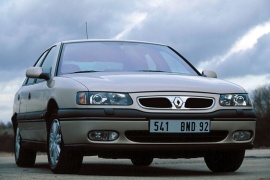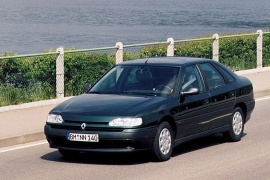RENAULT Safrane Models/Series Timeline, Specifications & Photos
First production year: 1992
Engines: Gasoline, Diesel
Body style: Hatchback
The Safrane was the last successful luxury vehicle from the French manufacturer. It was introduced on the market in 1992 and it was refreshed in 1996, like the last sprint of a marathoner.
The French luxury seemed to hardly keep up with the Germans. Its idea of front-wheel drive limousines didn't pay off. Even the Audi, the last brand to attend the premium market was already ahead of them with the introduction of the A6 and A8. The Safrane facelift was the last show before the fat lady sang.
Sleek and well proportioned, the 1996 Safrane featured a new grille on the front, with a different styling depending on the trim level. The clear-lens headlights were new as well. The taillights were mounted in an L shape, in an opposite way than the non-facelifted version. But it still retained the black door handles on most of the trim level and the steel wheels.
Inside, the Safrane offered different levels of comfort and features, depending on the trim level. From the basic, cloth, upholstery from the RN level up to the leather seats for the Initiale and Baccara.
The 1996 Safrane was offered with a choice of three gasoline and one diesel engines. Two of the gasoline versions were bought from Volvo, the V6 was a revamped engine developed in the late '70s with Peugeot-Citroen and the 2.2-liter turbocharged diesel. But all of them offered less power and higher fuel consumption than the German vehicles. In the end, the Renault Safrane was sold in fewer numbers than the Renault 25 which it replaced. The lack of drivetrains, new suspension systems and features along with the high price, made the car fall out from the premium segment and competing with the German non-premium brand Opel (Omega).
It was the last successful Renault executive vehicle. After that, all the other models suffered from various drawbacks. But not the Safrane. That was one of the best cars built by Renault in the '90s.
Renault used to be a premium car maker before WWII. After that, it was state-owned and that meant that they have to build vehicles imposed by the Economy minister. The most luxurious model from its lineup in the '90s was the Safrane, which was built for state officials and it replaced the aged Renault 25.
From the outside, the Safrane kept the same idea as the R25: medium-sized vehicles, with a liftgate in the back. The headlights were narrow and more expressive. A slim grille was helped for cooling by an additional grille installed in the apron. Since the car featured an additional, triangular, window behind the rear doors, the car was considered up-market for those times standards. The raked D-pillars made the greenhouse look sloped, even though the roof was flat.
Inside, Renault designers made different trim levels so the car could fit in the parking lot of a family or fit for state officials. The front seats were comfortable and wide, while the legroom for the rear occupants was more than decent. The instrument cluster was tilted forward and with a cover over it. There were two main gauges plus another three dials for oil pressure, fuel level, and coolant temperature. Few warning lights were installed under a black, translucent, panel.
For the drivetrain, Safrane offered something for everyone. From a very fuel-efficient 2.1-liter diesel to a turbocharged 3.0-liter V6, it had it all. It was even fitted with an all-wheel-drive system. The car was facelifted in 1996 and received more efficient engines.

